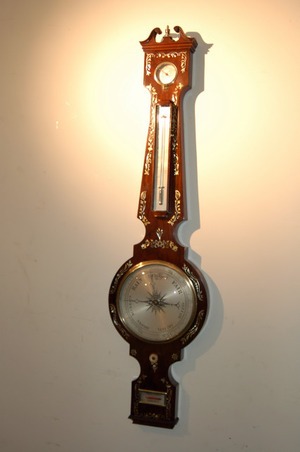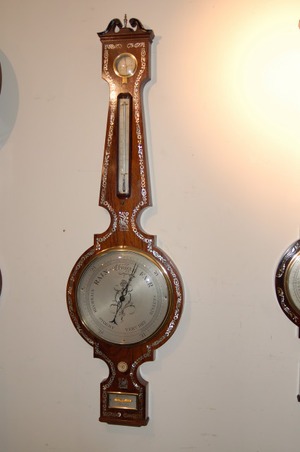
A superb rosewood veneered wheel barometer. Together with mother of pearl inlay. Finally thermometer, damp gauge and level indicator.

A superb rosewood veneered wheel barometer. Together with mother of pearl inlay. Finally thermometer, damp gauge and level indicator.

A fine wheel barometer. Together with rosewood veneers and mother of pearl inlay. Finally including damp guage, thermometer, and level.

A good mahogany ‘banjo’ wheel barometer. Shown with delicate shell inlay by P Conti of Burton. Thermometer to top section. Also with engraved silvered brass dial. To sum up a lovely item of good colour and patination.

A good mahogany ‘banjo’ wheel barometer. Featuring delicate shell inlay by A Bizaneli. Thermometer to top section. Also with engraved silvered brass dial. To sum up a fine piece of good colour.
Evangelista Torricelli is widely credited with the invention of the first barometer. Torricelli studied the workings of the great Galileo. He worked in the field of vacuum theory. Torricelli noticed weather changes effected the height of the liquid in Galileo’s water vacuum apparatus. These weather changes were related to air pressure fluctuations. One problem Torricelli had was the water vacuum apparatus required a tube 35ft long at sea level.
This meant on his home the apparatus he built was taller than his roof. People were very suspicious of strange experiments at the time and being accused of witchcraft was commonplace. He therefore needed to do something to keep his experiments more secretive. Discussion with Galileo before his untimely death in 1642 convinced Torricelli on the need to use a heavier material the water.
Mercury or Quicksilver as it was then called was used. Mercury is 14 times or thereabouts heavier than water. Torricelli found he only required a tube 32 inches long to keep his experiments going. It was therefore in 1643 the first working publicized barometer was invented. Torricelli died in 1647. Some of our barometers can be found by clicking here. https://www.pendulumofmayfair.co.uk/category/antiques-furnuture-clocks-rare-items .
Many people copied and perfected Torricelli’s experiments. Blaise Pascal and in September 1648 Florin Perier who was the brother-in-law to Pascal. At his request he took his barometer to the top of mountain. He lived here to see what effect it had on the height of the mercury. Pascals predictions were correct, the mercury was lower the higher one went.
It was not until about 1670 that barometers were starting to be sold and used in private homes. Lower pressures are associated with poorer weather and vice versa. It was found on fine sunny days the mercury stood at above 30 inches. On dull rainy days it stood at below 29 inches. It was decided anywhere in-between was changeable weather. A scale of 28 to 31 inches was decided upon and Fair. Changeable and Rain was engraved to the scale to correspond to the pressures. Later Stormy and Very Dry was added to the charts to correspond to 28 and 31 in Hg
Robert Boyle seems to be the first person to introduce the barometer to England. He was a writer and a student in Italy at the time of Torricelli’s experiments and studied the writings of Galileo. On his return to England he conducted various experiments of his own in this regard and came up with the famous Boyle’s Law deduction.
Daniel Clements
Dear Roy,
Please forgive the familiarity, only I am afraid I don’t know your surname. thank you so much for repairing my barometer! it has been in my family for such a long time and I am delighted to have it back in working order as it its so much more reliable than the weather forecast. A little note such as this is not enough to tell you how happy I am to see it working again, as it seems like an old friend who has been given a new lease of life! So very many thanks.
With kind regards and much appreciation,
I have featured previosuly many antique clocks from the 17th/18th and 19th centuries. As you probably know I am not a big fan of most 20th century clocks. There are still some fun clocks made during this period though and I will focus on a few here. The clocks I will be discussing here are so-called novelty clocks.
You will see from the picture above there are lots of things you can collect that are really fun and interesting. We have a selection of bicycle clocks, one of these even has a barometer in the back wheel. You can occasionally see such items on your travels. As with anything collectible you will probably expect to pay from about £500 to £750 for a nice example dating from the beginning of the 20th century.
You will notice candle clocks, oil lamp clocks and clocks where the eyes tell the time in the case of the dog. Clocks in the the form of a policeman, where the helmet is the alarm bell. There is an unusual petal clock, where the centre of the flower is the time and the mechanism is in the plant pot.
I hope you agree these are all very interesting and highly collectible antique clocks. Such items are increasing in value. If you start collecting and form a nice collection your money will be well invested. Our business can will advise in this regard.
Personally when I was young I used to collect Art Nouveau Balloon clocks. I have amassed a large collection of these over the years. My passion started when I was about 13 and have loved antique clocks all my life. I grew up in a family antique clocks business with its own in house antique clock restoration department. I had to either love antiques or hate them.
The more you understand about antique clocks, the more you love them. My advice is to start collecting when you are young. Learn from those willing to give you good advice and soak up all this information like a sponge. It is really rewarding now giving back to others all I have learnt over the years and I hope you continue to enjoy my blog.